(Last updated on January 9th, 2023)
Affinity Photo or Photoshop, which one should you pick and why? We researched and tested these programs to see how they stand against each other. Read our unbiased Affinity Photo vs. Adobe Photoshop comparison to make a smart decision.
For these two programs, we’ll be looking at how they work in terms of photography projects. We’ll review them in the areas of features, pricing, longevity, interface, and more. For each one of these categories, we’ll rate the apps on a scale of one to five.

Overview of Affinity Photo
Affinity Photo is a raster-based, powerful photo-editing program. Serif created the Affinity line in 2015 and it has become a part of the company’s trio of programs known as the Affinity Trinity. The other two programs are Affinity Designer and Affinity Publisher.
Pros
- Cheap pricing model with a one-time cost that is under $100.
- Easy to use interface that doesn’t take much time to learn.
- Ideal for both professionals and hobbyists.
Cons
- Less support is present with other programs in terms of output and compatibility.
- Limited features when compared to Photoshop.
- The workflow takes some getting used to.
Overview of Adobe Photoshop
Adobe Photoshop is one of the most popular programs in the world. It is raster-based and created by Adobe in 1987. Since that time, it has grown into a highly versatile program capable of so much more than photography edits.
Pros
- The powerful application is capable of photography edits, digital illustrations, animation, and video.
- Greater output of formats that can be used in other applications.
- Plenty of powerful plugins present to better customize your workflow.
Cons
- The monthly subscription cost makes the app an expensive one.
- The complex features take some time to learn.
- The interface will take some getting used to making it work with your workflow.
If you’re in a rush, here is the summary of the comparison.
Affinity Photo vs. Adobe Photoshop: At a Glance
1. Features
Winner: Adobe Photoshop. Overall, Photoshop inches out over Affinity Photo. It has a few more tools than what Affinity offers.
2. Pricing
Winner: Affinity Photo. Affinity Photo is available as a one-time purchase, unlike Adobe Photoshop. At $49.99 for either Windows or Mac, this software is an affordable price.
3. Longevity
Winner: Adobe Photoshop. Adobe Photoshop has more longevity than Affinity Photo because of its ubiquitous use and support of the huge Adobe family of applications. Many businesses use Adobe because of its huge software range, universities teach Adobe courses, and it’s a good universal program for creators to collaborate with across the globe.
4. User Interface
Winner: Tie. Affinity Photo and Photoshop are very similar in layout. From sleek black design to the panels and tools, the applications are identical in many ways.
5. Compatibility
Winner: Adobe Photoshop. Affinity files cannot be opened by other programs. They must be exported as a different file. Adobe Photoshop can be used by Affinity, GIMP, Krita, and other Adobe programs, to name a few.
6. Workflow
Winner: Adobe Photoshop. Adobe Photoshop has the most customizable workspace while Affinity Photo has a seamless Persona feature.
Both programs are complex and have great features that help the process. Overall, Adobe Photoshop’s workflow is better as a whole.
7. Users
Winner: Tie. Both professionals and hobbyists use Adobe Photoshop and Affinity Photo. They are great programs that can create great finished projects.
8. Learning Curve
Winner: Tie. Both Affinity Photo and Adobe Photoshop have many tutorials online to learn the programs. They are both complex and have their own unique set of challenges.
Short Verdict
Photoshop is the industry-standard tool that can tackle everything from photo editing and graphic design to animation and digital painting. Affinity Photo is an image editing software that offers all the necessary features and functionalities. Overall, Photoshop is the better program among the two.
Affinity Photo is the cheaper option thanks to its one-time payment option, but overall, Adobe Photoshop is the more powerful graphics editor. If you’re on a budget, Affinity Photo is a good choice. For professionals, there’s no better tool than Photoshop.
1. Features
Affinity Photo
- Powerful photo-editing capabilities. The tools have a huge range of functionality, allowing the user to do very detailed edits.
- Professional Color Modes: Has full CMYK, RGB, RGB Hex, LAB, and Grayscale modes.
- Default software comes with many presets for photography in the Tone Mapping persona.
- Saves Undo History after closing a project for up to 8,000 steps. Undo History is a great feature that protects you against accidental changes and lets you restore old versions.
- Live Brush preview, allowing you to see the brush effect before you use it.
- Workspace divided into personas: Photo, Liquify, Develop, Tone Mapping, and Export. Different tools come up with each persona, allowing less confusion and better workflow as you edit a photo. The personas take you from the beginning to the end of the editing process.
- The Develop persona in Affinity is used to edit raw images. This workspace allows you to make simple edits on the raw image to prepare it for further editing.
- Macros: A feature that allows the user to do multiple operations as one action. For example, you could apply a filter and change the exposure. Instead of taking all of the actions every time, you can apply the one macro, saving you so much time with batch editing.
- Resize and move an image with one tool, Move. (The equivalent would be two tools in Photoshop, Resize and Move.)
- It can create vector shapes using the shape or pen tools.
- Affinity is very compatible with Adobe: Can import .psd files, import Photoshop brushes, use most Photoshop plug-ins, and edit from Lightroom.
- Has many templates to choose from, organized by output.
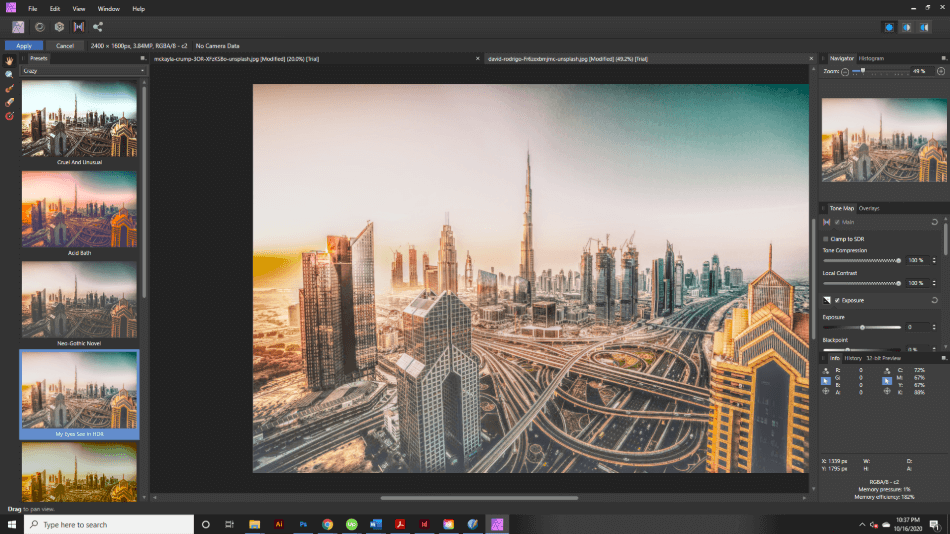
The many features present in Affinity Photo are easy enough to learn. However, that simplicity also comes with some limitations in how they are presented. For the limitations when compared to Photoshop, we’re taking off only a point.
Adobe Photoshop
- Exceptional photo-editing capabilities. The tools at hand are extremely precise and powerful, giving artists the most control over their photos.
- Handles big files exceptionally well, faster at processing.
- Has access to Adobe Typekit, a font library with thousands of fonts at your disposal. They are very easy to download and offload with the activate and deactivate buttons.
- It has access to Adobe Stock, a huge collection of stock images you can use for your projects. Each asset has a licensed credit, credits that you can get via subscription or purchase one at a time.
- It can sync with Cloud Documents, a powerful cloud-based storage system that lets you access your designs from anywhere, allowing you to browse and download from other devices. Cloud Documents work especially well when switching to different devices. An example is a desktop to a tablet workflow.
- Adobe Photoshop works great with the other family of applications. In particular, Adobe Camera RAW is a great plug-in that lets you import and enhance raw images. Photoshop also works great with InDesign, Lightroom, and Illustrator, to name a few other applications. Adobe has over 20 applications in total.
- Actions: A feature in Photoshop where you assign a series of tasks to one action. Actions are a great way to speed up batch editing. Photoshop comes with predefined actions. You can also customize actions for your projects too.
- Huge library of tutorials and resources available through Adobe. There are also many lessons and tutorials available from the outside community.
- Has tons of templates to choose from, sorted by output such as Print or Mobile.
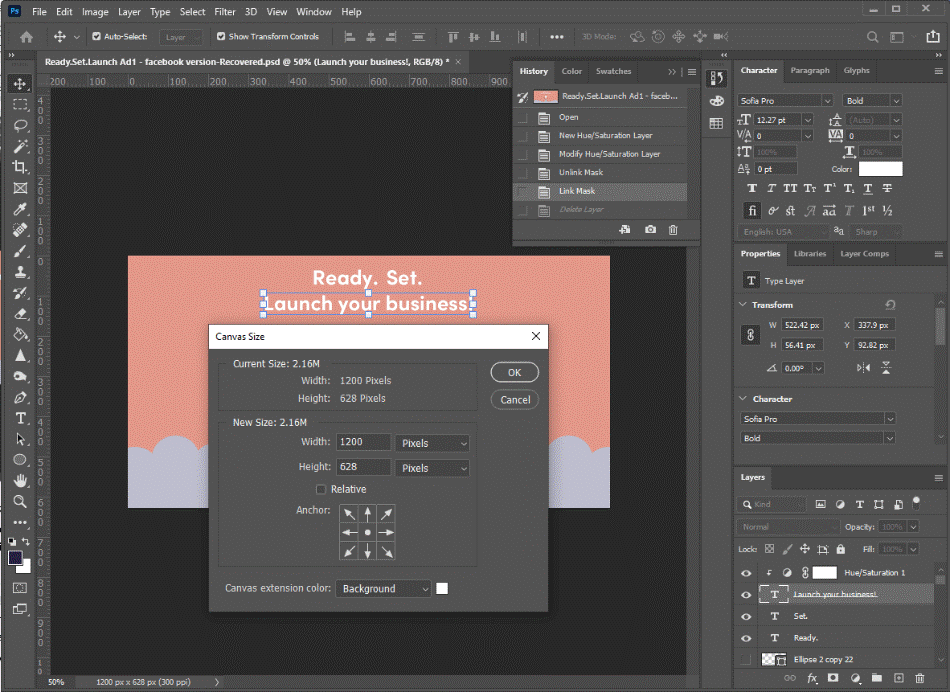
Photoshop’s various features are of the highest qualities, even if they do take some time to learn. With a range of functions that can aid in a slew of industries, the learning curve for these many features doesn’t seem so tough. Considering these aspects, we’re only deducting half a point for how long it’ll take to learn these many functions.
Winner: Adobe Photoshop. Affinity is missing some Adobe features. Unlike Affinity, Photoshop has 3D capabilities, animation, scripting, and a video timeline. Overall, Adobe Photoshop has more features than Affinity Photo.
2. Pricing
Affinity Photo
Affinity Photo is available for $49.99 as a one-time purchase. In Affinity’s shop, they offer supplementary brush bundles and illustration kits at an additional price. If you want the iPad version, you have to pay an additional $20.00. With the variety of cheap choices, Affinity gets a perfect score for pricing.
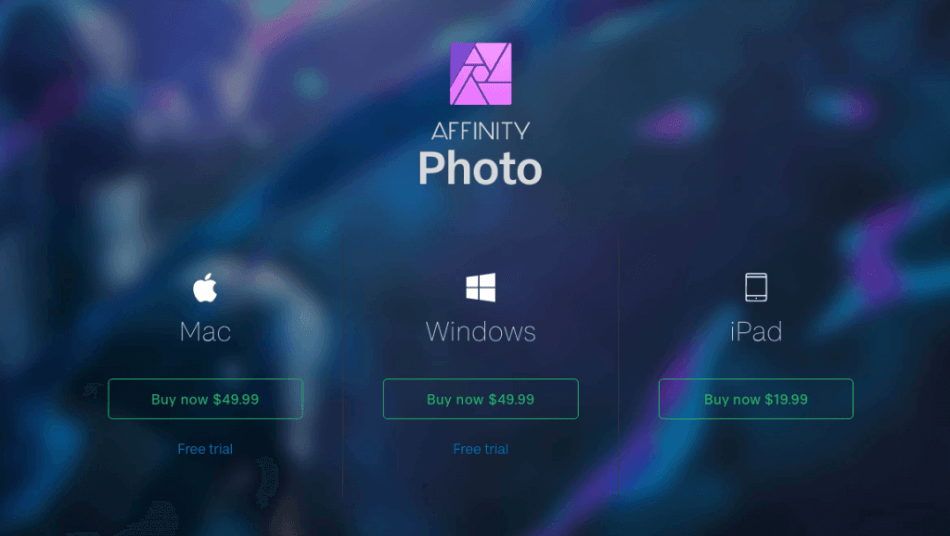
Adobe Photoshop
Adobe Photoshop is only available via subscription. While you can get discounts as a student or teacher, the lowest base rate is $9.99/month on annual terms for the Photoshop & Lightroom bundle.
If you want to cancel month-by-month, the cheapest plan is $31.49/month for just Photoshop. You do get the iPad version included in the subscription.
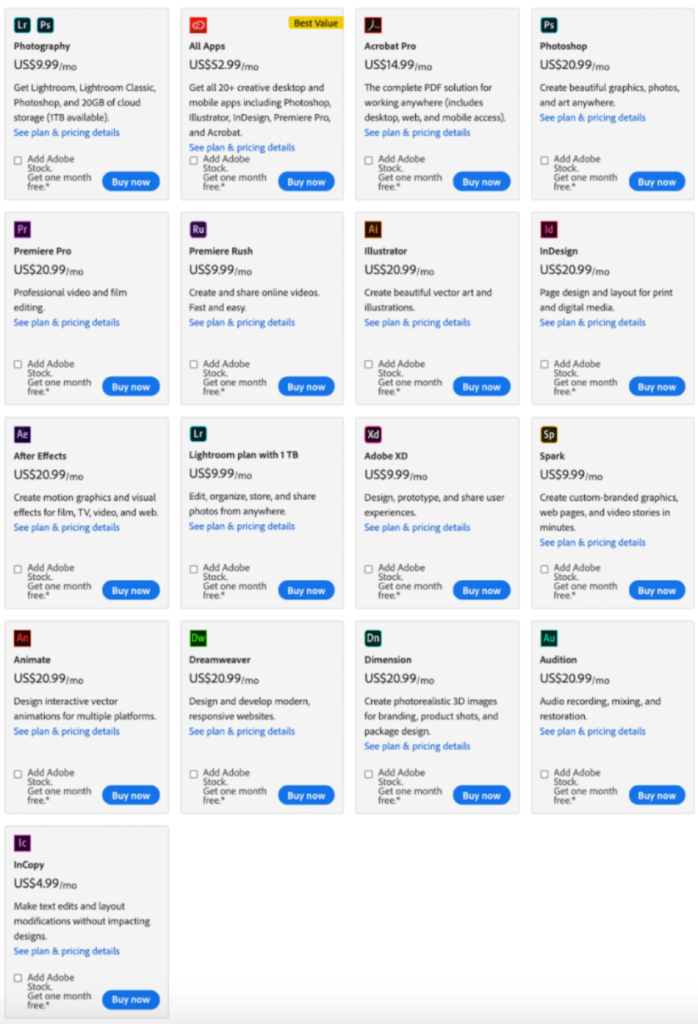
Affinity gives you free updates until the next version of a product. Usually, you will then get free updates for several years until they have a new big release. Meanwhile, the Adobe subscription includes the updates for life, but you must always have an active subscription.
An aggravating fact was that Adobe Photoshop used to be available as a one-time purchase from Adobe. Now, however, you can’t use Adobe Photoshop at all unless the subscription is active. For being so limited, we had to knock off a point and a half for the pricing of Photoshop.
Winner: Affinity Photo. In comparison, the one-time purchase of Affinity Photo makes it even more appealing. Because it’s a one-time purchase, you will always have some software version on hand even if you don’t want to pay for the newer version.
Overall, Adobe would get more expensive than Affinity within several months. Subscription fees add up fast. Affinity’s one-time purchase is worth it. If you want to learn more about Photoshop pricing plans, read our guide.
| Product | Regular Price | Discounted Price |
|---|---|---|
| Adobe Creative Cloud | $52.99/month | Check here |
| Adobe Photoshop | $20.99/month | Check here |
| Affinity Photo | $49.99 (one-time) | No Discount |
3. Longevity
Affinity Photo
Right now, Affinity doesn’t have a huge suite of programs. The trio right now consists of Affinity Photo, Affinity Designer, and Affinity Publisher.
Affinity Designer is a vector-based program, comparable to Illustrator, and Affinity Publisher is a desktop publishing program, comparable to InDesign. If Affinity creates a bigger suite of applications, that will put them closer to Adobe’s scope.
The longevity of Affinity Photo looks good but it’s not uncertain how strongly it will rise to match Adobe’s improvements. So far, the app doesn’t seem like a flash in the pan and may just have what it takes to be Photoshop’s top competitor. As it stands, however, the tough competition is leading to us deducting a point off its score.
Adobe Photoshop
Photoshop benefits from both its age and its publishers of Adobe. Adobe programs are used everywhere. Many businesses get the Adobe Creative Suite because it has such a huge range of capabilities.
There are programs for video editing, animation, vector graphics, web design, to name a few, plus Photoshop, all included in the same Creative Cloud bundle. Therefore, Photoshop and many Adobe programs are a requirement in creative jobs.
Because the creative community uses Adobe in the professional setting, Adobe products are often taught in college courses worldwide. Adobe can be considered an essential basis for a creative professional. While independent creatives may quit Adobe and use other software later, most know Adobe Photoshop.
Photoshop is a much older program than Affinity, made in the eighties versus 2015, the newer Affinity line released in 2015. Time and time again, Adobe has kept the program fresh and new, adding many features and bug fixes along the way.
Granted, while some updates can be buggy, Adobe support guides users, and the errors get fixed pretty quickly. We will watch to see if Affinity can adapt to the fast-past world of software as quickly as Adobe. For the time being, Photoshop’s outlook looks good with the competition only knocking off half a point.
Winner: Adobe Photoshop. Given how long Photoshop has been around, it’s safe to assume it’s not going to be going away anytime soon. It’s weathered plenty of competition over the years and continues to make improvements to be one of the top creative programs in the world. The clear winner is Photoshop for this category.
4. User Interface
Affinity Photo
Affinity Photo’s user interface is gorgeous. It’s all black, sleek, and easy to use. The design behind both Adobe Photoshop and Affinity Photo is very similar.
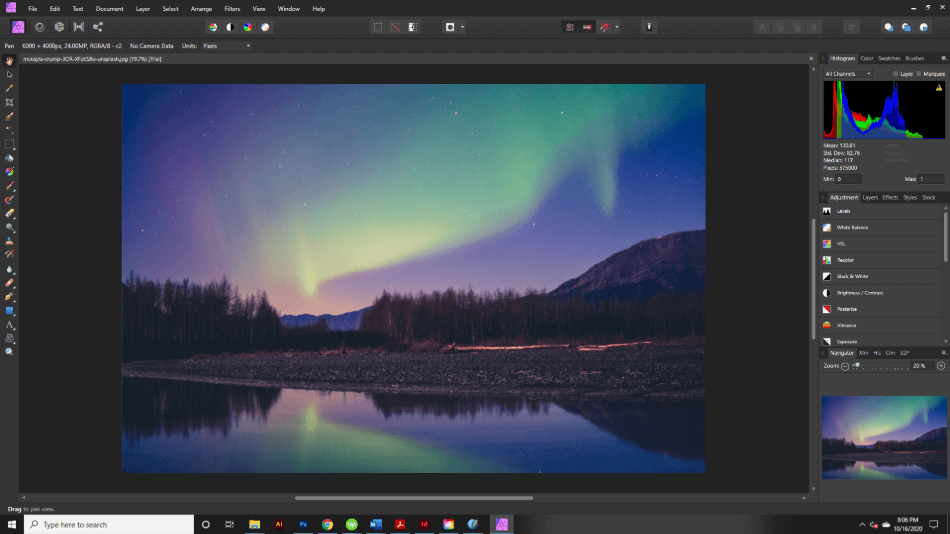
They have tools to the left, more panels to the right, and similar tabs up top. You can move panels around the workspace for both programs, the panels magnetically snapping to whichever side you want. Adobe allows you to save custom workspaces.
The biggest difference between Photoshop and Affinity is workspaces. Affinity Photo uses personas to divide up tasks, making the UI less cluttered. This means there’s less time you’ll have to spend tweaking the interface to your workflow and more time getting your projects finished.
For being so similar to Photoshop, Affinity also takes some time to get used to. There’s a bit of a learning curve to figuring out where all the tools and features are placed, even with the workspaces provided. For that learning curve, we’re deducting one point.
Adobe Photoshop
Adobe Photoshop can have personalized workspaces that you typically use for your whole project. The preset workspaces include Essentials, Graphic and Web, 3D, Motion, Painting, and Photography.
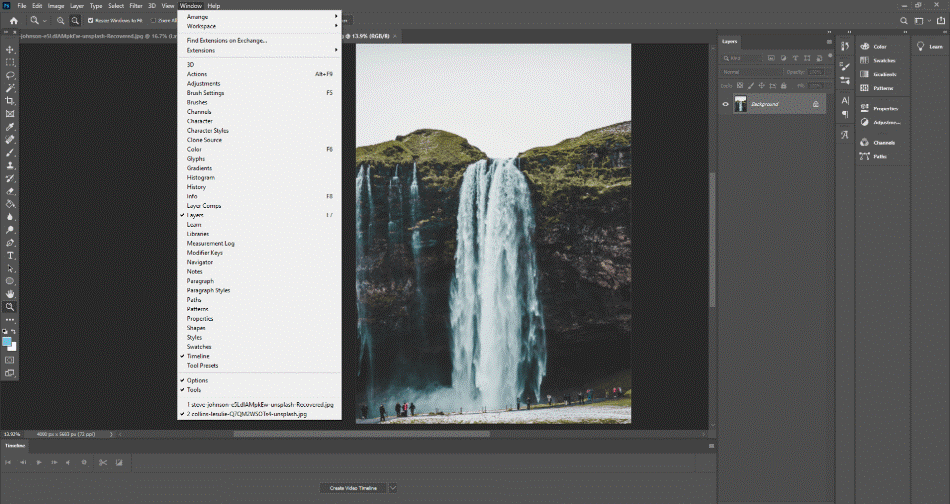
Overall, usage feels very similar and the user movements are intuitive. It takes some time to get used to all the workspaces but it’s worth the effort once you ease into the different interfaces. For that learning curve, we’re deducting one point.
Winner: Tie. Both Affinity Photo and Adobe Photoshop have clean, intuitive user interfaces. They have different pros and cons to each but have about the same level of skill when it comes to learning them. It is for this reason that we’re giving the apps a tie for interfaces.
5. Compatibility
Both Adobe Photoshop and Affinity Photo work for Mac and Windows users. They also have an application available on desktop and iPad. But there’s some stark differences to take note of.
Affinity Photo
Affinity Photo works great with Adobe Lightroom. You can start an image in Lightroom and finish it in Affinity, just like you could finish in Photoshop. Most Adobe Photoshop plug-ins also work in Affinity too. You can also import Photoshop brushes into Affinity Photo.
However, Affinity files can only be opened with the Affinity program. This limitation makes it incompatible with many other programs. For this major limitation that can hinder cross-program projects, we’re deducting a point and a half from its score.
Adobe Photoshop
Adobe Photoshop files can be opened in a variety of external programs. CorelDraw, Krita, GIMP, and many Adobe applications can all open .psd files. In addition, Photoshop can also recognize a variety of different file formats, including extra details contained within them.
This aspect plays well if you’re working with other Adobe applications. For example, if you’re working on assets you’ll be bringing into After Effects for animating, After Effects can recognize the layer of a PSD file. This makes the program exceptionally useful if you’re using Photoshop in conjunction with other mediums and apps.
It does take some time to figure out which aspects of the formats you should choose from and which applications will read your output. Adobe programs work well but you’ll have to look into any other apps you may be using. For learning this crucial aspect, we’re deducting a point.
Winner: Adobe Photoshop. Overall, Photoshop is more compatible than Affinity. Photoshop works with a variety of outside programs and works seamlessly in the Adobe software world.
| Affinity Photo | Adobe Photoshop | |
| Output Formats | JPEG, TIFF, BMP, EPF, GIF, TGA, HEIF, HEVC, CMYK, PSD, PSB | BMP, GIF, DICOM, HEIF/HEIC, IFF format, JPEG, JPEG2000, Large Document Format, PSB, OpenEXR, PCX, Photoshop 2.0 (Mac only), Photoshop DCS 1.0, Photoshop DCS 2.0, Photoshop EPS, Photoshop PDF, Photoshop PSD, Photoshop Raw, PICT, Pixar, PNG, Targa, TIFF |
6. Workflow
Affinity Photo
Lightroom is one of the best photo management tools out there. It is great for organizing large amounts of photographs. But, Lightroom is part of the Adobe family. Currently, Affinity Photo doesn’t have an equivalent program of its own.
The RAW feature in Affinity Photo is also significantly slower than Adobe’s version. The lack of speed when processing the huge raw files can slow down the editing process. For such slowness that can hinder production speeds, we’re deducting two points.
Adobe Photoshop
Adobe Photoshop’s interface is customizable, allowing the user to save custom workspaces. Meanwhile, Affinity Photo is set in Personas. While both programs allow you to move around panels, Affinity is more rigid.
Photoshop’s workflow is a bit more fluid once you save the right layout. There is a bit of a learning curve, however, so you’ll have to retool the program if you’re trying out the more advanced features of animation. For taking less time to learn than Affinity for the right workflow, we’re only deducting one point for the learning curve.
Winner: Adobe Photoshop. Both Adobe and Affinity have tools that help speed up the workflow. Overall, Adobe makes the process easier as a whole. That’s why Photoshop is the winner when it comes to workflows.
Overall, Adobe Photoshop has a better workflow because of access to Lightroom. While Affinity has access to a few other programs, Adobe’s compatibility and custom settings make it a great choice.
7. Users
Affinity Photo
Both professionals and hobbyists use Adobe Photoshop and Affinity Photo. Depending on what you need the software for, Affinity Photo might be perfect for you. Photoshop is extensive and can be overkill depending on the user’s needs.
Many graphic designers and photographers have a set workflow when they use software and tend not to veer far from their habits. Affinity does the majority of what Photoshop does. Sure, it has fewer tools. But, if you aren’t using them anyway, why stick with Photoshop?
Affinity Photo has a great photo-processing workflow. It’s different from Adobe Photoshop but still does many of the same things. Using personas, Affinity guides you from beginning to end. For such simplicity, we’re only deducting half a point.
Adobe Photoshop
The reason that some professionals stay with Adobe Photoshop is that it works seamlessly with the Creative Cloud family. This includes using Premiere if you’re a video editor or Illustrator if you’re a graphic designer. If you are already using the full suite, there is no reason to add Affinity to the mix.
Photoshop has a long history of users that are also more than helpful when it comes to offering handy tutorials. Adobe also offers plenty of support for new users as well. With such a wide range of different users, we’re only deducting half a point.
Winner: Tie. All users use both programs. Affinity is tailored for people who need less range from their software. Adobe Photoshop is good for people using the full Creative Cloud. In the end, they both have a wide audience which is why we’re giving this category a tie.
8. Learning Curve
Both Adobe Photoshop and Affinity Photo have many tutorials and lessons online. They are complex programs with a ton of tools to master.
Affinity Photo
Affinity Photo has an index tutorial inside the application. Here, it lists all of the topics that you would use, subdividing it into lessons to give you a step by step guide.
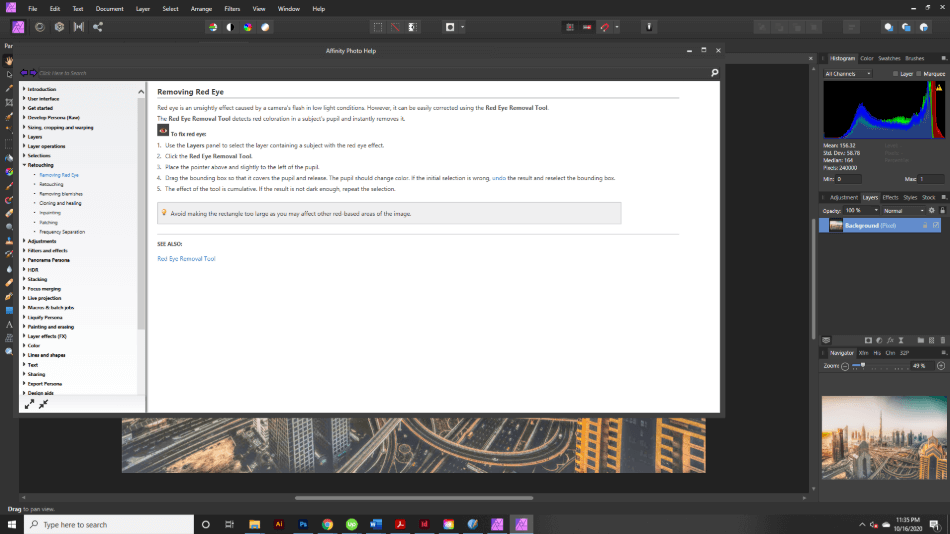
Affinity also has community forums. Here, professionals and peers answer posted questions. You can also browse and search previous posts to see if those inquiries apply to you. While Affinity doesn’t have a chat or phone feature, they do have email support.
Affinity offers an online Start Guide, guiding you through the basics of Affinity as a beginner. They have also offered a hardcover workbook, at an additional $49.99, teaching you and offering lessons on Affinity Photo. For offering a similar level of support to Photoshop, we’re also only deducting a half point.
Adobe Photoshop
Adobe Photoshop has a 24-hour, Monday-Friday chat available for support. They also have an extensive community forum available to ask and look for questions about the software. There are professional community guides that will answer questions as well as fellow creatives.
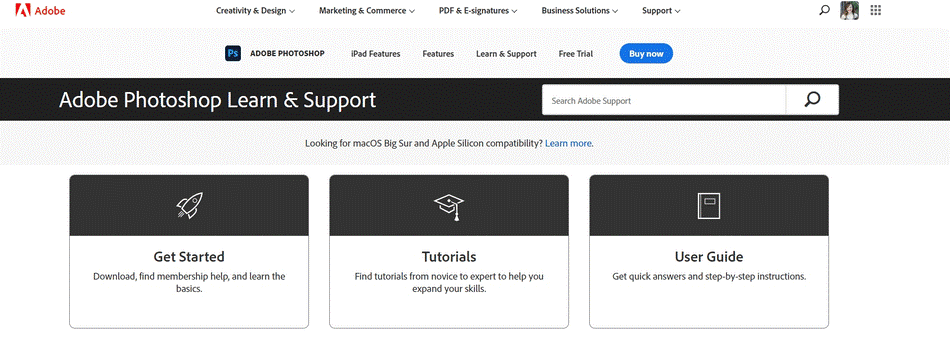
Adobe also has an extensive tutorial library. Here, there are written lessons and video tutorials to guide you through everything from Photoshop’s basics to advanced lessons.
There are also many external courses available through Skillshare, Lynda.com, and YouTube that teach users how to use Photoshop to the fullest. Photoshop also has in-app lessons, teaching you step by step how to use many essential tools.
There are so many resources available that the only major issue is that there are perhaps too many avenues to turn. Sorting through the various tutorials can be exhausting but you’re bound to find something that will aid in using Photoshop, no matter how niche it may be. For this reason, Photoshop’s learning curve only has a half-point deduction.
Winner: Tie. If you are a newbie who has never used a photo-editing software like Photoshop or Affinity, then you will find the software hard to learn. Layers, digital editing, painting, pixel vs. vector, and filters can be foreign concepts for beginners.
If you already have worked with Photoshop or Affinity, the change won’t be that difficult. The two programs have many similarities in terms of usability.
While Adobe is more extensive than Affinity and, therefore, more complex, the support system is more robust and complete. Affinity is slightly more intuitive and less overwhelming than Photoshop. In terms of the learning curve, these two are equals.
Verdict
Both Photoshop and Affinity Photo are powerful, raster-based photo-editing programs. Which one should you get? That depends on what your needs are.
If you currently only work with Adobe Photoshop and want to find a budget-friendly alternative, switching to Affinity Photo makes sense. You will save a ton of money and do almost everything that you can do in Photoshop.
If you currently use many of the Adobe programs, getting Affinity wouldn’t be the right choice. Photoshop does more than Affinity Photo and works seamlessly with the Creative Cloud Suite. If you have the full Suite, Affinity Photo would be an additional expense on top of the subscription you’d already be paying for.
Frequently Asked Questions (FAQs)
Head-to-head, Affinity is a great, affordable replacement to Photoshop. It can do almost everything that Photoshop does. The only areas that it lacks in is support for 3D effects and animation, if those are features you’d like to have.
Yes, Affinity Photo can open .psd files and edit straight from Lightroom, use most Photoshop plug-ins, and import Photoshop brushes.
Yes, Affinity Photo edits RAW photos in the Develop Persona. It’s similar to the Camera RAW plugin you can find in Photoshop or the non-destructive tools for editing RAW photos in Lightroom.
Affinity Photo has several more intuitive tools than Photoshop (Move tool, live brushes, Personas). Also, Affinity is a one-time purchase, unlike subscription-based Photoshop.
Affinity Photo can perform much of the same functions as both Photoshop and Lightroom. It has brush tools similar to that of Photoshop and features a non-destructive photo-editing format similar to that of Lightroom. You could use Affinity Photo as a substitute for either program.
While Affinity Photo does mostly match the features of Photoshop, it’s not as adept at some of the effects and tools. Specifically, Photoshop can handle 3D effects and can even accomplish the functions of animation. Affinity Photo can’t do much in this department, highlighting how the app is better suited for photo edits and most graphic design.
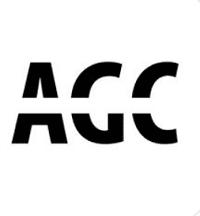
Anne is a filmmaker and writer with a passion to bring stories to life. She has created several short films, specializing in stop-motion animation. Anne has over eight years of filmmaking experience, and she is always ready to share her knowledge with other creators. She started her company Anne Gets Creative in 2020.
Anne is extremely familiar with many Adobe programs: Photoshop, Illustrator, InDesign, After Effects, Premiere, and Audition, to name a few. She has also worked with other programs such as Procreate, Canva, iMovie, and Final Cut Pro. She always strives to give the best software reviews, researching diligently so her readers don’t have to.

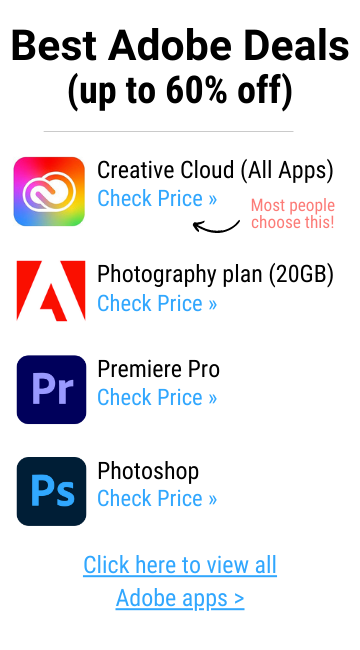

I agree with most of your points, but I don’t think you did the pricing comparison justice. In only 3 months one would have spent more money on Photoshop than on Affinity Photo. Also, Serif has done a lot on their own expense for aspiring artists by cutting their prices and giving multiple free trials. And I disagree with the UI point. Affinity is better than Photoshop in that regard.
Everything else is actually true. Photoshop is better in many ways, but you haven’t done these two points proper justice.
Totally agree with your comments.
What is the organization that develop industry standard in photo-editing?
Great post. I also agree with most points. However, as for longevity, Affinity is slowly trailing in with three major products in its suite, that covers the need of many professional designers and photographers. When they (Serif) creates a Lightroom alternative the suite is definitely very competitive.
As for Premiere Pro, we already have BlackMagic’s Davinci Resolve, which is free. So it will be interesting how the “battle” changes when Serif makes a Digital Asset Management for their Affinity Suite. So far Affinity Photo solves (I would say) 95% of the needs of most photographers, at a fraction of the price.
Learning Affinity Photo is not really a steep learning curve as Affinity Photo is quite similar to Photoshop. Even when it comes to tutorials.
Peter I read your other articles about Affinity Photo vs Photoshop and found them very useful for my recent decision of switching to Affinity due to the continuous price increase which is way to high.
But my question on this comment what about alternatives to Lightroom. I am reading about several of them to see for which one I decide. Similar case to Your Premiere Pro substitute, Davinci is not part of Affinity but a good replacement.
I wonder about the compatibilty of Affinity with macOS Monteray?
How does the vector function compare to photo shops use of vector?
Honestly I am not experienced with vector but want to learn.
I have no problems with the functionality and workflow of Photoshop. But, and it is a big but, the 2020 and 2021 releases have been problematic. The 2021 release is very slow and unresponsive. To be fair to Adobe, as cameras improve raw files get bigger. But, this is not the issue, as when comparing older versions of Photoshop to 2021 they are light years ahead on performance even with contempory files. Reading the Adobe photoshop email chain, it appears I am just one of hundreds that find Adobe has not done a good job with either enhancements or releases, and I suspect that under the hood, the application is suffering from code bloat. Affinity, though not as functional is much faster and more productive for most of my work. And a heck of a lot cheaper.
Thanks for sharing your thoughts, Ian.
I loved photoshop back in the day and used it for everything. Once they moved over to the subscription, I couldn’t bring myself to pay monthly for a product that I had previously paid an enormous amount to own for the little tweaks and adjustments they would make. Once I discovered Affinity, I haven’t looked back and doubt I ever will.
Totally – as a web designer / developer I used PS for years. Then I purchased Affinity and never looked back!
One comment I would like to add to this evaluation which I noticed missed in most of the post and articles about switching from Creative Cloud apps to some other app and it is about CPU and Memory resources. Once I uninstalled all of Creative Cloud (also used their installation cleaner) I was surprised on the huge improvement in my cpu and memory resources. Maybe only happened to me, but my PC is kind of breathing clear again!.
Ditto what Nick wrote. I paid $600 for Photoshop 3.0.5 in 1996, and that was the student academic price. I continued to pay large sums of money for updates in subsequent years, but once Adobe moved to subscriptions, that’s when I stopped updating. Affinity is literally a godsend. Once I became with Afffinty’s workflow, anything I did in Photoshop I could achieve in Affinity Photo. And it just keeps getting better and better. Just like Nick, I haven’t looked back and doubt I ever will.
I use Photoshop CC primarily to restore old photos from the 1800s and early 1900s – cracks, spots & stains, fading, silvering, missing parts, color correction, etc. How does Affinity compare to Photoshop CC when used for this purpose?
My request to Affinity is with regards to a replacement for Adobe Acrobat. In today’s world I need to provide a PDF editor, we are still using Acrobat, for all day-to-day functions. The subscription price just for Acrobat is untenable for a 40 person design firm. I am looking forward to when Affinity has an Acrobat substitute for a reasonable price.
Agree with the review and comments, Need to question your thoughts on Longevity. Serif have been in the PC Graphics world since 1993-1994. Affinity Has a history that is almost as impressive as Photoshop and has provided a well priced alternative to Photoshop (DrawPlus, PhotoPlus, Page Plus….)